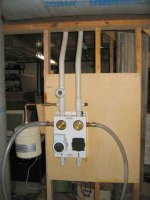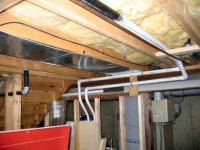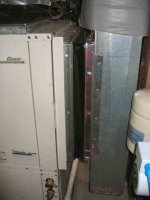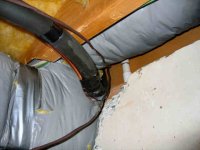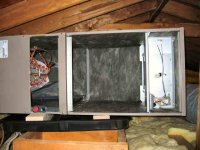Chapter 8
The inside work was now starting. First was to get the circ panel in. To connect the loop to the circ panel, I transitioned to PVC with standard glue joints. Temps and conditions are fine for PVC, and if there is a joint problem, it is readily accessible. I added a small expansion tank (recommended to me) to keep the loop pressure steadier. The manufacturers do not recommend a tank, and the loop pressure varies from about 30 PSI to 80 PSI seasonally. Using the small tank I have had a 3-4 PSI variation. A potable water tank should be used. They have the fluid in contact only with the bladder, and not the steel surface (furnace tanks sometimes have the air in the bladder and water against steel). Using this style minimizes the chance of any corrosion in the loop.
Another decision was to use bent joints in the PVC rather than fittings. This was done to reduce pressure drops in the loop, to maximize flow rate. Bending was done with a heat gun and layout table. You need to be careful to maintain diameter and avoid wall thinning when bending PVC. Experience at it is the best tool.
The panel has the pump and a blanking cover for a second pump, used in the 2 pump models. The brass disks are the 3-way valves to select closed, flushing or running positions. The side fittings are for flushing and the bottom fittings go to the units..
Continued on Chapter 9
paul
The inside work was now starting. First was to get the circ panel in. To connect the loop to the circ panel, I transitioned to PVC with standard glue joints. Temps and conditions are fine for PVC, and if there is a joint problem, it is readily accessible. I added a small expansion tank (recommended to me) to keep the loop pressure steadier. The manufacturers do not recommend a tank, and the loop pressure varies from about 30 PSI to 80 PSI seasonally. Using the small tank I have had a 3-4 PSI variation. A potable water tank should be used. They have the fluid in contact only with the bladder, and not the steel surface (furnace tanks sometimes have the air in the bladder and water against steel). Using this style minimizes the chance of any corrosion in the loop.
Another decision was to use bent joints in the PVC rather than fittings. This was done to reduce pressure drops in the loop, to maximize flow rate. Bending was done with a heat gun and layout table. You need to be careful to maintain diameter and avoid wall thinning when bending PVC. Experience at it is the best tool.
The panel has the pump and a blanking cover for a second pump, used in the 2 pump models. The brass disks are the 3-way valves to select closed, flushing or running positions. The side fittings are for flushing and the bottom fittings go to the units..
Continued on Chapter 9
paul
